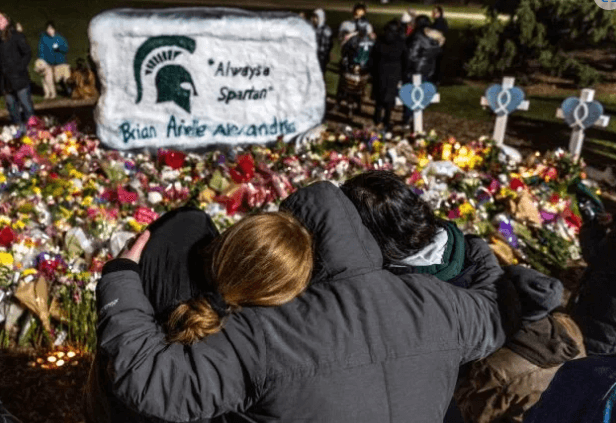A gunman shot eight Michigan State University (MSU) students, killing three and critically wounding five others, on Monday, Feb. 13.
The students killed were Alexandria Verner, Brian Fraser, and Arielle Anderson. All victims were transported to Sparrow Hospital in Lansing, Michigan.
As reported by NPR.org, the gunman, Anthony McRae, 43, stormed Michigan State University’s Berkey Hall during evening night classes, killing two of the three students. The third student was killed at the MSU Student Union, a building nearby.
President Patrick Leahy, Ed.D., alerted University community members to the tragic incident via email on Tuesday, Feb. 14, Valentine’s Day and the five-year anniversary of the mass shooting at Marjory Stoneman Douglas High School in Parkland, Florida.
“What happened at Michigan State University is truly tragic, and so are the countless gun murders and mass shootings across the United States and beyond. These acts have been steadily increasing in recent years,” started Saliba Sarsar, Ph.D., Professor for the Department of Political Science and Sociology.
The Gun Violence Archive, an independent data collection organization, recorded the mass shooting at MSU as the 67th in 2023. The organization defines a mass shooting as involving the shooting or killing of four or more individuals, excluding the perpetuator.
According to John Comiskey, Ed.D., Associate Professor for the Department of Criminal Justice, mass shootings lack standardized criteria.
“There are several definitions of mass shootings. Congress authorized federal support (ATF, FBI, DHS, etc.) to aid state and local police departments in investigating mass shootings with three or more fatalities,” explained Comiskey. “The Congressional Research Service’s criteria is four or more fatalities— the most common definition.”
Comiskey teaches undergraduate and graduate intelligence courses, which examine threats, such as mass shootings, terrorism, climate security, and public health concerns.
McRae, the lone shooter, is not believed to have any connection to the victims at Michigan State. He fled the scene on foot and died of self-inflicted wounds upon confrontation with police.
During the week the shooting occurred, McRae’s father, whom he lived with, and sister were interviewed by the New York Post. With the shooter dead, there is no full-proof way of understanding his motives.
“The state and local police department, with the assistance of the FBI, the Bureau of Alcohol, Tobacco, and Firearms (ATF), and others, will seek to identify a motive and further investigate the shooter for possible other firearms that may be stored elsewhere. Family, friends, neighbors, and associates will be interviewed for further details. The shooter’s acquisition of firearms will be scrutinized extensively,” elaborated Comiskey.
The Detroit News discovered that McRae was arrested in June of 2019 for carrying a concealed pistol without a concealed carry permit as found in Ingham County’s court records.
“Tragedies such as these incite the gun control argument, but because McRae had a prior felony conviction and was able to get a handgun, there lies the question as to how he was able to obtain one,” explained Nicholas Sewitch, J.D., Specialist Professor and Chair for the Department of Criminal Justice.
He continued, “Michigan doesn’t have universal background checks, so it is quite possible that whoever sold him the gun didn’t know he had a conviction.”
Likewise, Comiskey predicts the ways in which the state of Michigan will respond to this incident. “Typically, there is a call for stricter gun laws, red flag laws, mandatory sentencing for firearms possession/use, and greater restrictions on gun ownership.”
Sewitch agrees that one of the main takeaways from mass shootings is how to prevent them from happening again in the future.
Carlos Ortiz, Chief of Monmouth University’s Police Department (MUPD), described what the MUPD is doing to ensure the campus’ safety.
“The University police department actively works to not only empower our community members to become aware of their surroundings and potentially dangerous situations, but to also educate our officers in the proper response to de-escalate and mitigate any threat of harm against anyone,” began Ortiz.
“Students may have noticed an increase in the frequency of our officers walking through buildings and maintaining a heightened visible presence throughout the campus.”
Ortiz plans to also host informal, weekly “Chat with the Chief” sessions in McAllan Hall (Room 115), beginning Tuesday, Feb. 28 to discuss faculty and students’ ideas regarding safety and security.
“One of the issues for every college campus is how to maintain an open, democratic, and free environment conducive to learning that protects its members,” posed Sewitch. “College campuses, along with sporting arenas and grocery stores, are soft targets. In a democratic society, you can’t lock things up to the extent that you can guarantee anyone’s safety.”
This semester, Comiskey’s graduate class is examining 2022 mass shootings, such as Topps Supermarket (Buffalo), Robs Elementary school (Texas), and Club Q (Colorado), and their implications for Monmouth County, like the Monmouth Mall, Monmouth University, Monmouth Racetrack, NJ Transit, Monmouth Sheriff’s Office, and Asbury Park.
Ortiz recommends that every campus member take an active part in securing Monmouth’s campus. “If you see something, say something; report any suspicious activity; walk in well-lit areas and try to avoid walking alone at night; always lock your car doors and never leave valuables in sight; know the locations of the emergency call boxes located on campus and notify us if any phone is not working properly,” advised Ortiz.
MSU has organized several vigils in honor of the lives lost. One of the most recent vigils took place on Monday, Feb. 20, exactly one week from the shooting.
Sarsar cited solace from Rev. Dr. Martin Luther King Jr., “As the Rev. Dr. Martin Luther King Jr. believed, ‘love is the only force capable of transforming an enemy into a friend.’ We must work harder to reflect thoughtfully on our shortcomings and the violence around us. We must redouble our efforts to engender dialogue, inclusion, empowerment, equality, human security, safety, and justice, and have these enshrined in law. In so doing, we can actualize our potential and build together a healthier and more secure future.”



